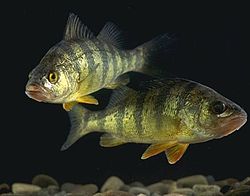Yellow Perch
| Yellow perch | |
|---|---|
 |
|
| Scientific classification | |
| Kingdom: | Animalia |
| Phylum: | Chordata |
| Class: | Actinopterygii |
| Order: | Perciformes |
| Family: | Percidae |
| Genus: | Perca |
| Species: | P. flavescens |
| Binomial name | |
|
Perca flavescens Mitchill, 1814 |
|
The yellow perch (Perca flavescens), commonly referred to as perch, is a freshwater perciform fish native to much of North America. The yellow perch was described in 1814 by Samuel Latham Mitchill from New York. Yellow perch are closely related, and morphologically similar to the European perch (Perca fluviatilis); however, the two are recognized as independent species based on anatomical and genetic differences. Other common names for yellow perch include American perch, coontail, lake perch, raccoon perch, ring-tail perch, ringed perch, and striped perch.
Latitudinal variability in age, growth rates, and size have been observed among populations of yellow perch, likely resulting from differences in day-length and annual water temperatures. Typically, northern populations of yellow perch live longer and grow to larger sizes. However, southern populations of yellow perch generally grow much faster. In many populations, yellow perch often live from 9–10 years, with adults generally ranging from 4–10 inches in length.
The world record yellow perch (18 in., 4 lb. 3 oz.) was caught in 1865 from New Jersey, and is the longest standing record for freshwater fish in North America.
The yellow perch has a yellow to brass-colored body and distinct pattern, consisting of five to nine olive-green, vertical bars, triangular in shape, on each side. Its fins are lighter in coloration, with an orange hue on the margins. The body is laterally compressed. The anterior portion of the body is deep, gradually tapering into a slender caudal peduncle. The opercle is partially scaled, and a single spine is present on the posterior margin.
As with all percid fishes, yellow perch have two dorsal fins. The anterior is convex in shape and consists of 11–15 spines. The posterior dorsal fin has a straight margin, consisting of one or two spines and 12–16 rays. The nape, breast, and belly of yellow perch are all fully scaled. A complete lateral line (50–70 scales) is present. The anal fin consists of two spines and six to nine rays. A single spine and five rays make up the pelvic fins, and the pectoral fins consist of 13–15 rays. The caudal fin of the yellow perch is forked.
Yellow perch are only found in North America; they are native to the Arctic, Atlantic, Great Lakes-St. Lawrence River, and Mississippi River basins. In Canada, its native range extends throughout Nova Scotia and Quebec north to the Mackenzie River. It also is common in the northwest to Great Slave Lake and west into Alberta. It is not native to any other areas of Canada. In the United States, the native range extends south into Ohio, Illinois, and throughout the majority of the northeastern United States. It is also considered native to the Atlantic Slope basin, extending south to the Savannah River.
...
Wikipedia

